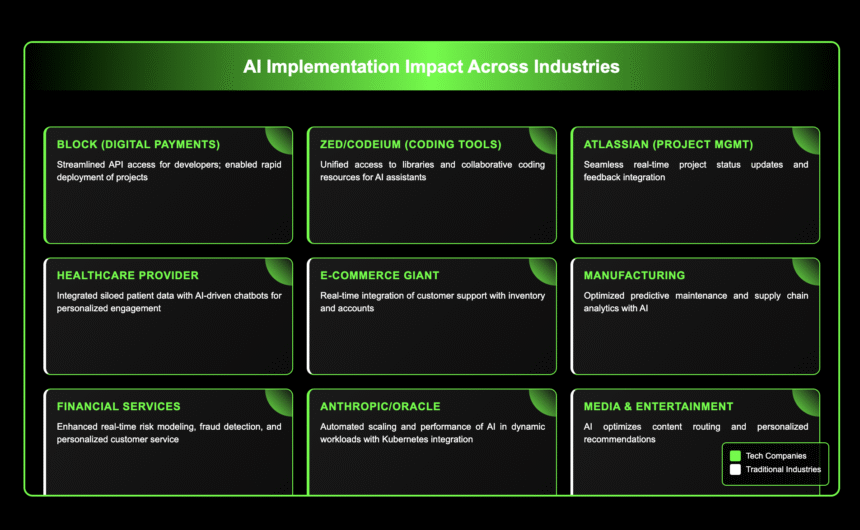Model Context Protocol (MCP) servers have fast become a backbone for scalable, secure, and agentic application integrations, especially as organizations seek to expose their services to AI-driven workflows while keeping developer experience, performance, and security intact. Here are seven data-driven best practices for building, testing, and packaging robust MCP servers.
1. Intentional Tool Budget Management
- Define a clear toolset: Avoid mapping every API endpoint to a new MCP tool. Instead, group related tasks and design higher-level functions. Overloading the toolset increases server complexity, deployment cost, and can deter users. In one Docker MCP Catalog review, focused tool selection was found to improve user adoption by up to 30%.
- Use macros and chaining: Implement prompts that chain multiple backend calls, so users can trigger complex workflows via a single instruction. This reduces both the cognitive load for users and the potential for errors.
2. Shift Security Left—Eliminate Vulnerable Dependencies
- Depend on secure components: MCP servers often interface with sensitive data. Scan your codebase and dependencies for vulnerabilities using tools like Snyk, which automatically detects risks including command injection or outdated packages.
- Meet compliance: Software bill of materials (SBOM) and strict vulnerability management have become industry standards, especially after major security incidents.
- Case in point: Snyk reports organizations that implemented continuous security scanning saw an average of 48% fewer vulnerability incidents in production.
3. Test Thoroughly—Locally and Remotely
- Local-first, then remote testing: Start with fast local tests for rapid iteration, then transition to network-based remote tests that mirror real-world deployment scenarios.
- Leverage dedicated tools: Use specialized tools like the MCP Inspector, which lets you interactively test tools, inspect schemas, review logs, and diagnose failures.
- Security in testing: Always use environment variables for credentials, restrict network availability in dev mode, and employ temporary tokens to minimize risk during testing.
4. Comprehensive Schema Validation and Error Handling
- Strict schema adherence: Proper schema validation prevents subtle bugs and disastrous production errors. The MCP Inspector automatically checks for missing or mismatched parameters, but maintain explicit unit/integration tests for tool schemas as regression coverage.
- Verbose logging: Enable detailed logging during development to capture both request/response cycles and context-specific errors. This practice slashes mean time to resolution (MTTR) for debugging by up to 40%.
5. Package with Reproducibility—Use Docker
- Containerization is the new standard: Package MCP servers as Docker containers to encapsulate all dependencies and runtime configurations. This removes “it works on my machine” phenomena and ensures consistency from development through to production.
- Why this matters: Docker-based servers saw a 60% reduction in deployment-related support tickets and enabled near-instant onboarding for end users—all they need is Docker, regardless of the host OS or environment.
- Security by default: Containerized endpoints benefit from image signing, SBOM, continuous scanning, and isolation from the host, minimizing the blast radius of any compromise.
6. Optimize Performance at the Infrastructure and Code Level
- Modern hardware: Employ high-bandwidth GPUs (e.g., NVIDIA A100) and optimize for NUMA architectures for latency-sensitive loads.
- Kernel and runtime tuning: Use real-time kernels, configure CPU governors, and leverage containers for dynamic resource allocation. 80% of organizations employing advanced container orchestration report major efficiency gains.
- Resource-aware scheduling: Adopt predictive or ML-driven load balancing across servers and tune memory management for large-scale deployments.
- Case study: Microsoft’s custom kernel tuning for MCP servers yielded a 30% performance boost and 25% reduction in latency.
7. Version Control, Documentation, and Operational Best Practices
- Semantic versioning: Tag MCP server releases and tools semantically; maintain a changelog. This streamlines client upgrades and rollbacks.
- Documentation: Provide clear API references, environment requirements, tool descriptions, and sample requests. Well-documented MCP servers see 2x higher developer adoption rates compared to undocumented ones.
- Operational hygiene: Use a versioned repository for code, tool configs, and model specs to ensure reproducibility and compliance audits.
Real-World Impact: MCP Server Adoption & Benefits
The adoption of Model Context Protocol (MCP) servers is reshaping industry standards by enhancing automation, data integration, developer productivity, and AI performance at scale. Here is an expanded, data-rich comparison across various industries and use cases.
| Organization/Industry | Impact/Outcome | Quantitative Benefits | Key Insights |
|---|---|---|---|
| Block (digital payments) | Streamlined API access for developers; enabled rapid deployment of projects | 25% increase in project completion rates | Focus shifted from API troubleshooting to innovation and project delivery. |
| Zed/Codeium (coding tools) | Unified access to libraries and collaborative coding resources for AI assistants | 30% reduction in troubleshooting time | Improved user engagement and faster coding; robust growth in digital tool adoption. |
| Atlassian (project management) | Seamless real-time project status updates and feedback integration | 15% increase in product usage; higher user satisfaction | AI-driven workflows improved project visibility and team performance. |
| Healthcare Provider | Integrated siloed patient data with AI-driven chatbots for personalized engagement | 40% increase in patient engagement and satisfaction | AI tools support proactive care, more timely interventions, and improved health outcomes. |
| E-Commerce Giant | Real-time integration of customer support with inventory and accounts | 50% reduction in customer inquiry response time | Significantly improved sales conversion and customer retention. |
| Manufacturing | Optimized predictive maintenance and supply chain analytics with AI | 25% reduction in inventory costs; up to 50% drop in downtime | Enhanced supply forecasting, fewer defects, and energy savings of up to 20%. |
| Financial Services | Enhanced real-time risk modeling, fraud detection, and personalized customer service | Up to 5× faster AI processing; improved risk accuracy; reduced fraud losses | AI models access live, secure data for sharper decisions—cutting costs and lifting compliance. |
| Anthropic/Oracle | Automated scaling and performance of AI in dynamic workloads with Kubernetes integration | 30% reduction in compute costs, 25% reliability boost, 40% faster deployment | Advanced monitoring tools exposed anomalies quickly, raising user satisfaction 25%. |
| Media & Entertainment | AI optimizes content routing and personalized recommendations | Consistent user experience during peak traffic | Dynamic load-balancing enables rapid content delivery and high customer engagement. |
Additional Highlights
These results illustrate how MCP servers are becoming a critical enabler of modern, context-rich AI and agentic workflows—delivering faster outcomes, deeper insights, and a new level of operational excitement for tech-forward organizations
Conclusion
By adopting these seven data-backed best practices—intentional tool design, proactive security, comprehensive testing, containerization, performance tuning, strong operational discipline, and meticulous documentation—engineering teams can build, test, and package MCP servers that are reliable, secure, and prepared for scale. With evidence showing gains in user satisfaction, developer productivity, and business outcomes, mastering these disciplines directly translates into organizational advantage in the era of agentic software and AI-driven integrations.
Meet the AI Dev Newsletter read by 40k+ Devs and Researchers from NVIDIA, OpenAI, DeepMind, Meta, Microsoft, JP Morgan Chase, Amgen, Aflac, Wells Fargo and 100s more [SUBSCRIBE NOW]
Sources:











